
Symphyotrichum novae-angliae is a species of flowering plant in the aster family (Asteraceae) native to central and eastern North America. Commonly known as New England aster, hairy Michaelmas-daisy, or Michaelmas daisy, it is a perennial, herbaceous plant usually between 30 and 120 centimeters tall and 60 to 90 cm wide.
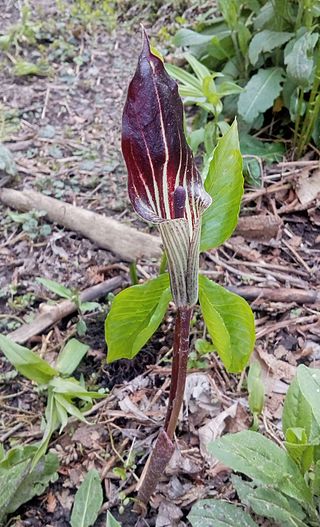
Arisaema triphyllum, the Jack-in-the-pulpit, is a species of flowering plant in the arum family Araceae. It is a member of the Arisaema triphyllum complex, a group of four or five closely related taxa in eastern North America. The specific name triphyllum means "three-leaved", a characteristic feature of the species, which is also referred to as Indian turnip, bog onion, and brown dragon.

Tiarella, the foamflowers, is a genus of flowering plants in the family Saxifragaceae. The generic name Tiarella means "little turban", which suggests the shape of the seed capsules. Worldwide there are seven species, one each in eastern Asia and western North America, plus five species in eastern North America. As of October 2022, the taxonomy of Tiarella in eastern North America is in flux.

Alice Morse Earle was an American historian and writer from Worcester, Massachusetts.
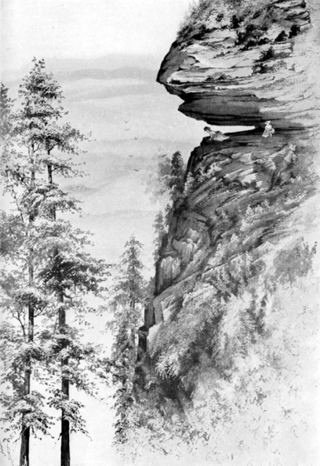
Alice Lounsberry was an American botanist and author active in the United States during the late 19th and early 20th centuries. Some sources give her birth year as 1872. She worked closely with the Australian botanical artist Ellis Rowan, publishing three books with her as illustrator.

Chauncey Delos Beadle was a Canadian-born botanist and horticulturist active in the southern United States. He was educated in horticulture at Ontario Agricultural College (1884) and Cornell University (1889). In 1890 the landscape architect Frederick Law Olmsted hired him to oversee the nursery at Biltmore Estate in Asheville, North Carolina on a temporary basis. Olmsted had been impressed by Beadle's "encyclopedic" knowledge of plants. Beadle ended up working at Biltmore for more than 60 years, until his death in 1950. He is best known for his horticultural work with azaleas, and described several species and varieties of plants from the southern Appalachian region. He and three friends, including his "driver and companion" Sylvester Owens, styled themselves the Azalea Hunters. The group traveled over the eastern United States for a period of fifteen years, studying and collecting native plants. In 1940 Beadle donated his entire collection of 3,000 plants to Biltmore Estates.

Frances Theodora Parsons, who initially published as Mrs. William Starr Dana, was an American naturalist and author active in the United States during the late 19th and early 20th centuries. She wrote a number of books, including a popular guide to American wildflowers.

Alice Eastwood was a Canadian American botanist. She is credited with building the botanical collection at the California Academy of Sciences in San Francisco. She published over 310 scientific articles and authored 395 land plant species names, the fourth-highest number of such names authored by any female scientist. There are seventeen currently recognized species named for her, as well as the genera Eastwoodia and Aliciella.

Sibbaldia tridentata is a species in the plant family Rosaceae. Its synonyms include the illegitimate name Sibbaldia retusa and Sibbaldiopsis tridentata. Under the latter name, it has been treated as the only species in the genus Sibbaldiopsis. Its English names include three-toothed cinquefoil, shrubby fivefingers, and wineleaf.

Symphyotrichum lateriflorum is a species of flowering plant in the aster family (Asteraceae). Commonly known as calico aster, starved aster, and white woodland aster, it is native to eastern and central North America. It is a perennial and herbaceous plant that may reach heights up to 120 centimeters and widths up to 30 centimeters.

Helianthus maximiliani is a North American species of sunflower known by the common name Maximilian sunflower.
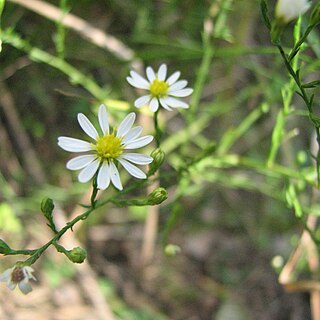
Symphyotrichum depauperatum, commonly known as serpentine aster or starved aster, is a rare species in the family Asteraceae adapted to serpentine barrens, an ecosystem with a high concentration of toxic metals in the soil. It has been found in Pennsylvania, Maryland, and on some diabase glades in North Carolina. It grows to 50 centimeters and has white ray florets surrounding a center of yellow disk florets.
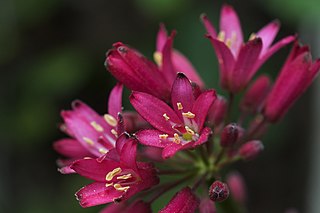
Clintonia andrewsiana is a species of flowering plant in the lily family Liliaceae. The species was discovered by John Milton Bigelow in 1854 and described by John Torrey in 1856. The specific epithet andrewsiana honors Timothy Langdon Andrews (1819–1908), a "gentleman who assiduously examined the botany" of California during the mid-19th century. The species is commonly known as Andrews clintonia or red clintonia, where the latter refers to the color of the flowers. In California, it is also known as bluebead lily or western bluebead lily, not to be confused with C. borealis, which is likewise known as bluebead lily. The Pomo people of northern California consider the plant to be poisonous.
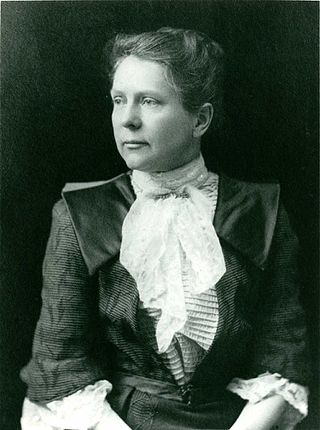
Elizabeth Gertrude Britton was an American botanist, bryologist, and educator. She and her husband, Nathaniel Lord Britton, played a significant role in the fundraising and creation of the New York Botanical Garden. She was a co-founder of the precursor body to the American Bryological and Lichenological Society. She was an activist for the protection of wildflowers, inspiring local chapter activities and the passage of legislation. Elizabeth Britton made major contributions to the literature of mosses, publishing 170 papers in that field.

Arisaema quinatum is a species of flowering plant in the arum family Araceae. It is a member of the Arisaema triphyllum complex, a group of closely related taxa in eastern North America. The specific name quinatum means "divided into five lobes", a reference to its characteristic leaves. It is commonly known as the southern Jack-in-the-pulpit but some refer to it as Preacher John.
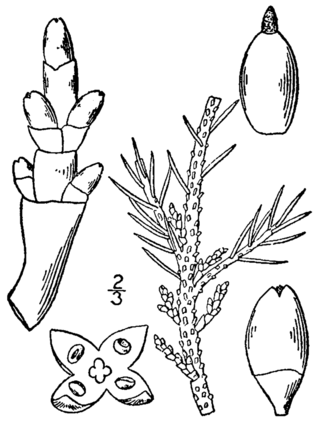
Arceuthobium pusillum is a perennial, obligate parasitic plant in the sandalwood family. Its common names include Dwarf mistletoe or Eastern dwarf mistletoe. It is one of the most widespread dwarf mistletoes within its range which covers the eastern United States and Canada, from Saskatchewan to Nova Scotia and New Jersey. The species name "pusillum" derives from Latin "pusillus", meaning very small.
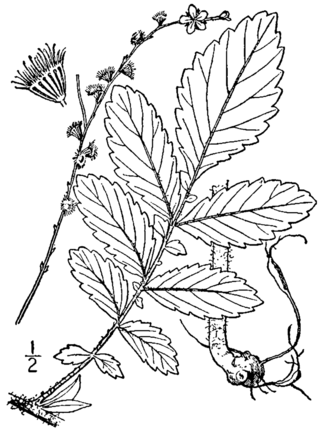
Agrimonia pubescens, the soft agrimony or downy agrimony, is a flowering plant in the genus Agrimonia, a member of the rose family. It grows in dry areas and woodlands.

















